Yerevan, Armenia
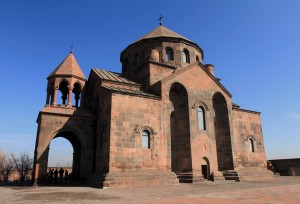
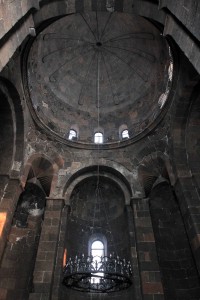
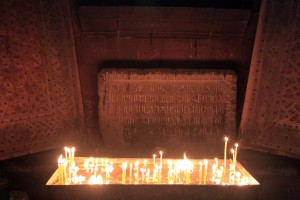
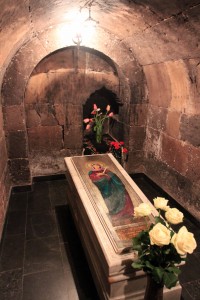
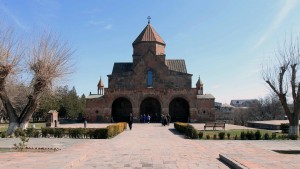
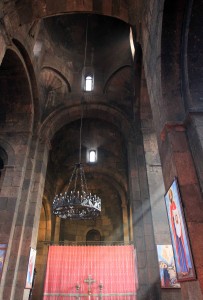
I woke up at 09:00 today, showered, dressed, had a cup of coffee, and then waited around until just after 11:00, when the tour guide/driver was ready to take myself and six Russians (one guy – who spoke the most English and acted as translator for me since the guide/driver spoke none (though the driver does have two daughters attending University in the United States) – and five women; the guy and four of the women work for a travel agency in Moscow and are doing this tour today and one tomorrow as part of their job – must be nice to travel around the world!). Once ready, we loaded in to the tour bus (a minivan similar to the marshrutkas) and drove off through Yerevan, to our first stop: the Church of St. Hripsimé, which was erected in 618 AD by Catholicos Komitas atop the original mausoleum built by Catholicos Sahak the Great in 395 AD that contained the remains of the martyred Saint Hripsimé to whom the church was dedicated. Once the tour bus arrived at the church, we exited the vehicle and walked around and inside the church (where the tombstone of Saint Hripsimé, with her painted likeness on top, is located). After touring the church, we reentered the tour bus and drove to the next site on our itinerary: the Church of St. Gayane, which was built by Catholicos Ezra I in the year 630 AD; the church sits on the site where Saint Gayane (an abbess) was martyred by Tiridates III of Armenia in the year 301 AD, during the time Armenia’s conversion to Christianity. The full story of Saints Hripsimé and Gayane, taken from Wikipedia.org follows: The fifth century Armenian historian Agathangelos wrote that the young and beautiful Hripsimé who at the time was a Christian nun in Rome, was to be forcefully married to the Roman emperor Diocletian. She and the abbess Gayané among other nuns fled the tyrant emperor and left to Armenia. The pagan Armenian King Trdat received a letter from Diocletian in which he described her beauty. Trdat discovered where the nuns were hiding, and fell in love with Hripsimé and later Gayané. After her refusal of his advances, Hripsimé was tortured and martyred at the location of Saint Hripsimé Church, while Gayané was tortured and martyred at this site where the church was later built. The remaining group of thirty-eight unnamed nuns were martyred at the location of Shoghakat. During the time that Hripsimé was being tortured, Gayané told her to “be of good cheer, and stand firm” in her faith. King Trdat was to be later converted to Christianity and made it the official religion of the kingdom.
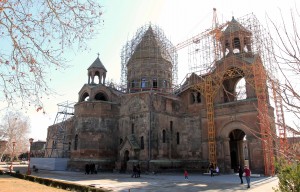
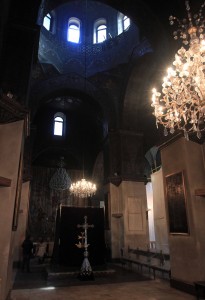
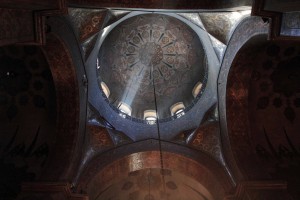
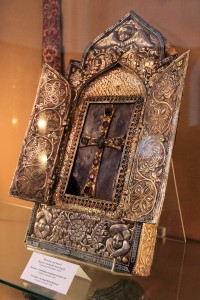
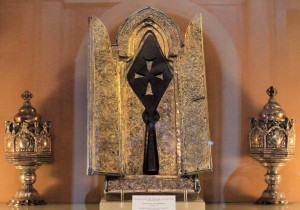
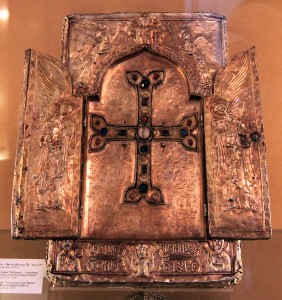
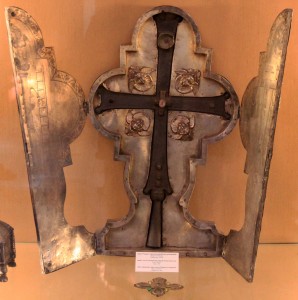
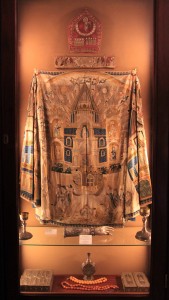
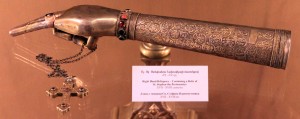
After touring the Church of St. Gayane, we returned to the bus and were driven to Etchmiadzin Cathedral, the mother church of the Armenian Apostolic Church, located in the city of Vagharshapat; it is the first cathedral (though not the first church) built in Armenia and it is considered the oldest cathedral in the world. The original cathedral was built between 301 and 303 AD by Armenia’s Patron Saint, Gregory the Illuminator, following the adoption of Christianity as a state religion by King Tiridates III; inside the cathedral, in the center, under the dome, is a curtained spot where – according to legend – Saint Gregory the Illuminator had a vision of Jesus Christ descending from heaven and striking the earth with a golden hammer to show where the cathedral should be built. Surrounding the cathedral, are many other buildings, gardens, and monuments, which we walked past as we made our way through the complex, to the cathedral. There was some restoration work being done on the outside and inside, but the cathedral still maintained its marvelous and awe-inspiring beauty. After walking around the cathedral, the tour guide bought tickets for us to enter the museum attached to the structure; inside the museum are some of the most important Christian artifacts and makes the visit completely worthwhile. We were assigned a tour guide, who spoke in Russian for my six temporary comrades and then explained the important artifacts to me in English. Inside the museum, were numerous religious vestments, staffs, manuscripts, coins, icons, and reliquaries; the most significant items were a fragment of Noah’s Ark (which, according to tradition, landed at the nearby Mount Ararat, where Noah also famously planted a vineyard and made wine – fitting for this region, the Cradle of Winemaking), the Holy Lance that pierced Jesus Christ while on the Cross (there are two other spears in the world that are claimed to be the Holy Lance; one is in the Treasury in Vienna, which I have been fortunate enough to see, and the other is underneath a statue of St. Longinus, located in St. Peter’s Basilica in the Vatican; based on what I’ve read, the one in the Vatican is most likely to be the true Holy Lance (although neither of them can be authenticated and, more than likely, none are the true Holy Lance); however, the Holy Lance at Etchmiadzin Cathedral was supposedly brought to Armenia by the Apostle Thaddeus (one of the Seventy, not Jude Thaddeus of the original Twelve) during the first-century AD), a reliquary containing a piece of the True Cross, the Battle Cross of the Armenian King Ashot II Yerkat (which also has a piece of the True Cross in it), the cauldron that contains the Holy Chrism (used throughout the Armenian Church for the Sacrament of Baptism and Chrismation, Ordination of Clergy, Consecration of Bishops, Final Rites of Clergyman, Blessing of the Water Service, and Consecration of new Churches – the latest batch still in the cauldron was created in 2008 AD and is nearly finished), an icon from the Havuts Tar Monastery dated to the ninth- or tenth-centuries AD (the oldest icon in the collection), a Right Hand Reliquary (a metallic sculpture of a saint’s right hand and arm) containing a relic of St. Luke the Evangelist and other saints, a Right Hand Reliquary containing a relic of St. George, a Right Hand Reliquary containing a relic of St. Stephan (the first Christian martyr), and a Right Hand Reliquary containing a relic of St. John the Baptist. After touring the museum, I exited the cathedral and walked around the Armenian Church complex before returning to the tour bus. Once all of the passengers had returned to the bus, we drove to our next destination.
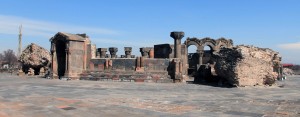
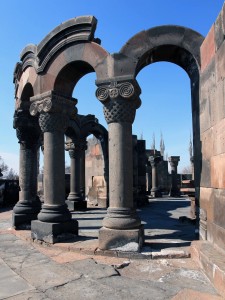

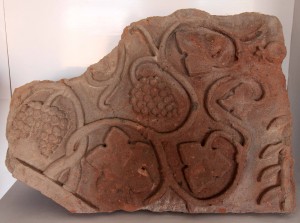
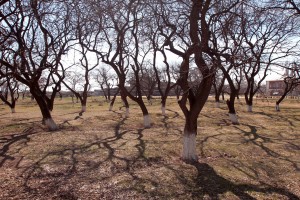
The tour bus soon reached the ruins of Zvartnots Cathedral and, after parking, we walked to the ruins and were met by a guide that would show us all around the historic site; unfortunately, the guide only spoke Russian, so I followed the group, but focused more on taking photographs rather than paying attention to the guide. Zvartnots Cathedral was commissioned by Catholicos Nerses III from the Taik region between the years 643-652 AD; the cathedral was built on the spot where St. Gregory the Illuminator met King T’rdat, initiating the king’s conversion and leading Armenia to adopting Christianity as the state religion (the first nation to do so, in 301 AD); the cathedral remained standing until its collapse in the tenth-century AD. The Russians and I followed the guide’s lead and walked around the ruins of the cathedral, pontifical residence, wine press, and the museum. After completely touring Zvartnots, we returned to the tour bus and drove off.
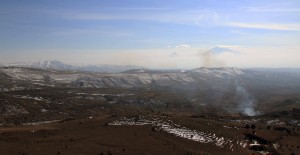
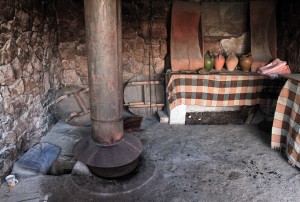
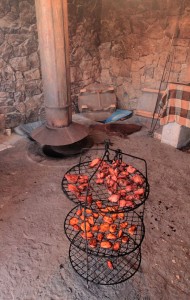
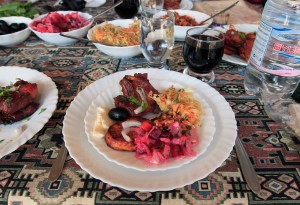
We then stopped at a lookout point on the side of the road, the Ararat (Charents) Arch, which was erected in 1957 AD and offers a breathtaking view of Mount Ararat, just across the border, in Turkey. After taking in the site of the historic mountain where Noah is believed to have landed his Ark after the flood, we drove onward through a landscape that still hasn’t recovered from Winter and where snow can still be found at the higher elevations (I’m not sure when the best time would be to visit Armenia, but I’m guessing it would look best in the Autumn, when all the leaves are changing color); we then drove to a small town where we stopped at a very nice and traditional restaurant to have a late lunch. For our meal, we had bread, vegetable greens, cheese, olives, beets, a type of coleslaw, a type of risotto, and barbeque pork and potato slices (cooked in an Armenian tonir – “tonir” is the Armenian word for “tandoor” and is a cylindrical oven buried underground where meat and vegetables are cooked on a rack or skewers); we also had a red wine made from Areni grapes that tasted smooth and of plums, green peppers, and musk. After lunch, we thanked the restaurateurs and returned to our vehicle.
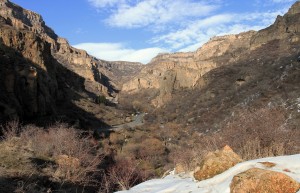
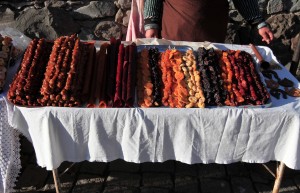
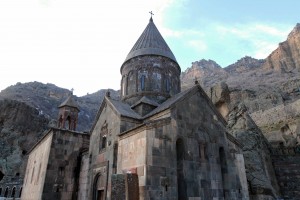
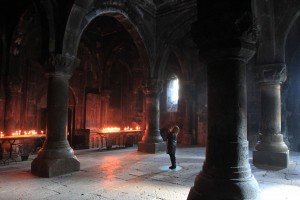
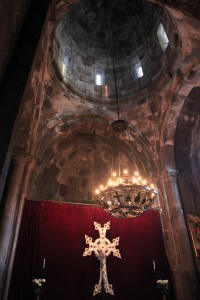
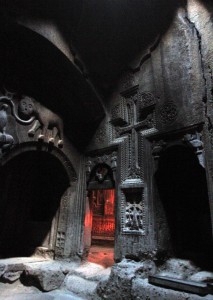
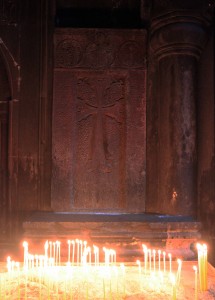
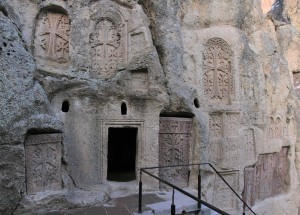
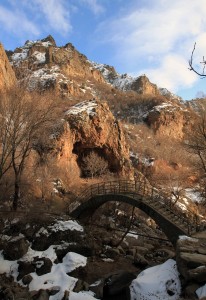
Next, we drove to the Geghard Monastery, a medieval monastery in the Kotayk Province of Armenia; the monastery sits in the Azat River Gorge and was founded in the fourth-century AD by Saint Gregory the Illuminator at the site of a sacred spring; the name Geghard, or, more fully, “Geghardavank”, means “the Monastery of the Spear,” and is where the Holy Lance first came from the Apostle Thaddeus; the current monastery is believed to be a product of the thirteenth-century AD. Once the tour bus parked next to the monastery, I got out of the vehicle and immediately began to explore the complex (we weren’t given too much time at this and other sites); I walked inside the Katoghikeh Gavit and then in to the Katoghikeh; I then followed the passage that led to the Proshian Sepulchre and then to the Proshian Church; I then returned to the Katoghikeh Gavit and entered inside the Avazan, where the sacred spring waters runs through. After touring the Katoghikeh and its adjacent and connected structures, I walked up to the monk’s cells that are carved in to the cliff face at the Geghard Monastery; then, I walked to the stream that runs by the monastery and enjoyed the beautiful views. Finally, after touring the monastery, I returned to the parking lot where many vendors were selling dried meats, fruits, and traditional bread (large circular and decorative pieces). Once we all returned to the tour bus, we drove to the nearby ancient pagan temple.
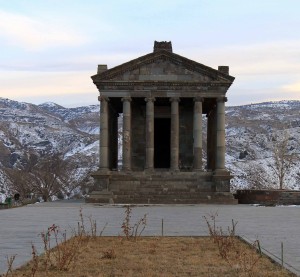
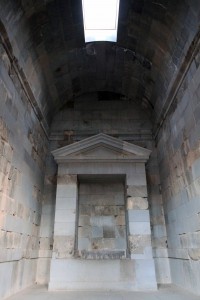
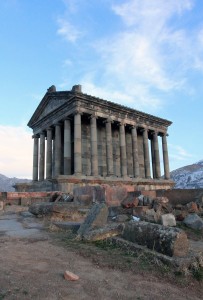
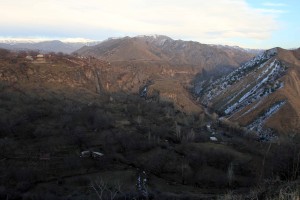

The next and final site for our tour today was the ancient site of Garni, one of the oldest settlements in Armenia; a site that has a fortress wall, many ruins, and is famous for its Hellenistic temple, the Temple of Mihr. The site is located next to the Garni Gorge, which was carved out by the Goght River, and it was also first occupied during the third millennium BC. I walked around the ruins of Garni and entered inside the reconstructed pagan temple (it was originally destroyed by the earthquake of 1679 AD); I enjoyed the sunsetting rays of light against the stone temple and valley, and it was a nice location to have our last stop for the day. Also, in the parking lot, I tried some homemade pomegranate wine being sold by a local vendor; the pomegranate wine tasted more like juice rather than wine, and I decided not to purchase any of it. We then drove back to Yerevan. Once we entered in to the city, the tour driver/guide stopped near a supermarket for some of the Russian ladies to exchange their currency; well, we waited for them to return and they finally did after nearly an hour – they had gone shopping in the supermarket and taken their sweet time too; this irked me as well as the Russian guy (they stole an hour of my life!); finally, we drove the rest of the way to the hostel and arrived at 20:30. I then loaded the photos I had taken today (over 500) on to my laptop and went through them all; also, I used an Armenian delivery website to order a bottle of wine and a pizza, to be delivered to the hostel. The delivery arrived just after 22:00 and I ate the spicy pizza made with pepperonis and Italian sausages, and I drank the bottle of Armenian red wine produced in the Artsakh Region; the wine tasted of wild berries with a hint of vanilla. I also decided to join the tour for tomorrow (once again, it would be the six Russians and myself) which would take us further away from Yerevan and in to the majestic Armenian countryside (I’m starting to really like this country). Finally, I went to sleep some time after 01:00.
